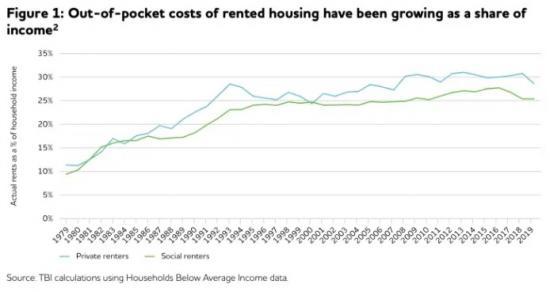Housing Affordability Since 1979: Determinants And Solutions
22nd January 2023

It's the housing costs that people pay each month, not house prices, that matter most to us at Resolution. Once you take that perspective you spend a lot of time looking at surging housing costs in the 1980s and early 90s - in 1979, both private and social renters spent about 10 per cent of their incomes on rent, vs. 30 and 25 per cent respectively now.
Why did that happen is the focus of a great new report (blog summary) by the Tony Blair Institute for JRF. It's not because underlying rents are ever rising, but because we've stripped back the three big policies that shelter tenants from those market rates: rent controls went decades back, social housing has become more heavily rationed, and the rising Housing Benefit bill (which has been left to take the strain) has been cut, and is out of fashion with both anti-landlord lefties and anti-spending Thatcherites.
The paper is basically about resurrecting the case for the goal of protecting lower income households from market housing costs - including via Housing Benefit. This is a) right and b) not what anyone wants to hear. - Torsten Bell at The Resolution Foundation.
From one of the authors of the report - Ian Mulheirn
Housing affordability since 1979
Rented housing has become increasingly expensive in recent decades. Why?
One of the most striking charts in public policy is the one that shows how much household income has come to be swallowed up by rent. Little more than a generation ago renters in both the private and social rented sectors typically spent just 10% of their incomes on rent. Today that proportion has jumped to around 30% for private renters and 25% for social tenants, which represents a pretty extraordinary increase in these households' rent payments (see Fig.1).
[url=https://medium.com/@ian.mulheirn/housing-affordability-since-1979-fe18d32f0250]Read the full blog HERE[/url]
The Report
Housing affordability since 1979: Determinants and
solutions
by Ian Mulheirn, James Browne, Christos Tsoukalis.
Rents in the private and social rented sectors are close to their highest for decades as a share of tenants' incomes - this report examines why, and the policy options that could help tenants stay afloat.
What you need to know
• Reversing the decline in housing subsidies is key to enhancing the affordability of housing for renters. The value of housing subsidies has fallen from 16.5% of total day-to-day cost of housing services in the national accounts in 1979 to 11.5% in 2019-20. If housing subsidies had remained at their 1979 levels as a share of total housing costs, they could have been worth £45 billion in 2019-20 rather than their actual level of £31 billion.
• The erosion of subsidies explains the decline in housing affordability for renters over the past 40 years. This underlines the importance of subsidies if housing affordability is to be improved.
• The appropriate mix of housing subsidies should be determined by differentiating beteen the needs of different household types.
Social housing is the most appropriate solution for lo-income families.
With children, pensioners and those With a disability. An additional 700,000 social properties would allow the level of social renting among lower-income families with children to return to its 1979
level and the share of lower-income working-age disabled people living in private rented accommodation to be reduced below 10%.
• Housing Benefit should remain a complementary policy tool to help households who are temporarily poor, or for whom labour mobility and choice are the most important considerations. To improve the experience of renting in the private sector, policy-makers should end the Local Housing Allowance freeze, re-link rates to the 30th percentile of local rents and introduce the reforms to the private rented sector outlined in the recent ‘fairer private rented sector' White Paper.
Read the full report HERE
